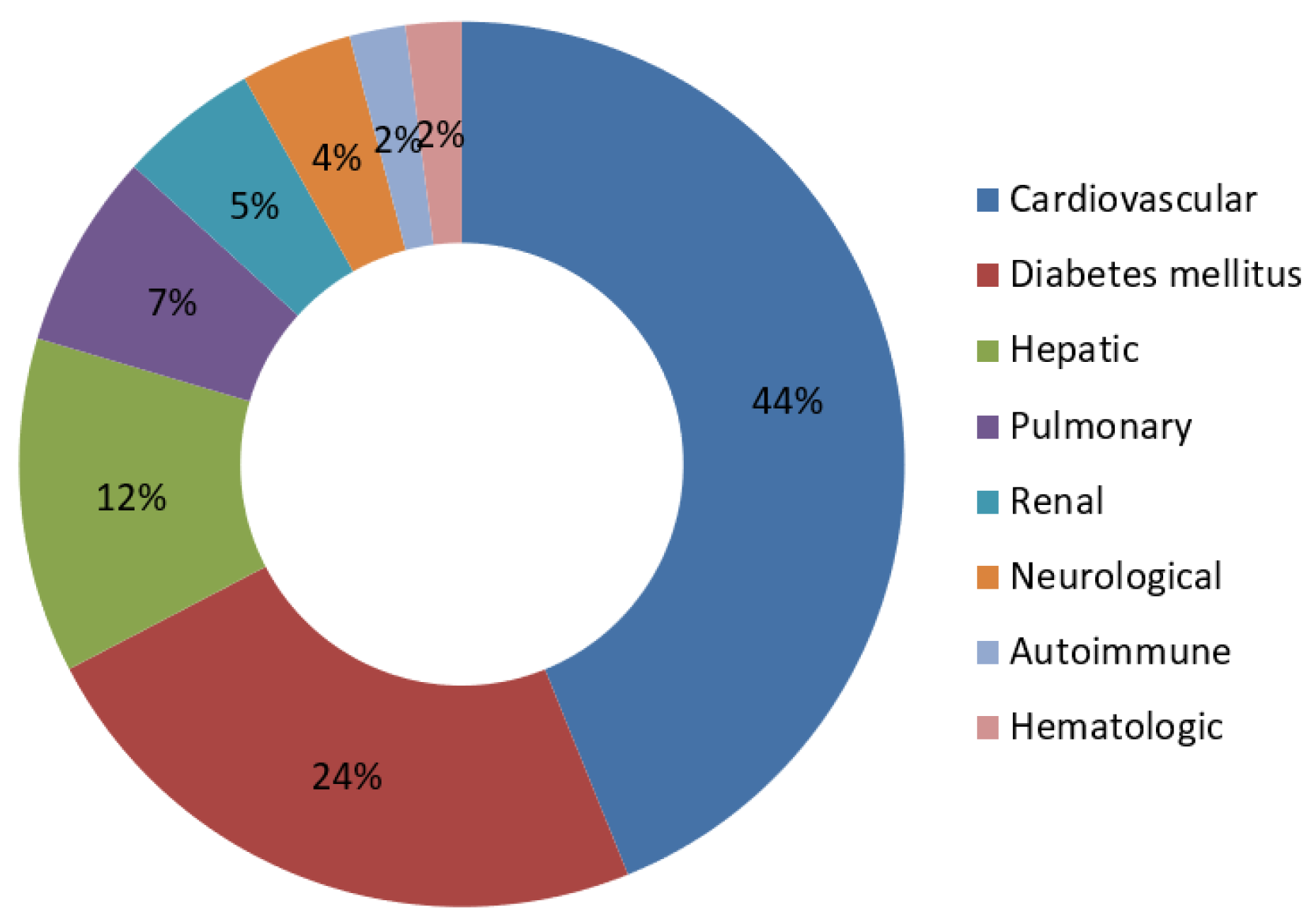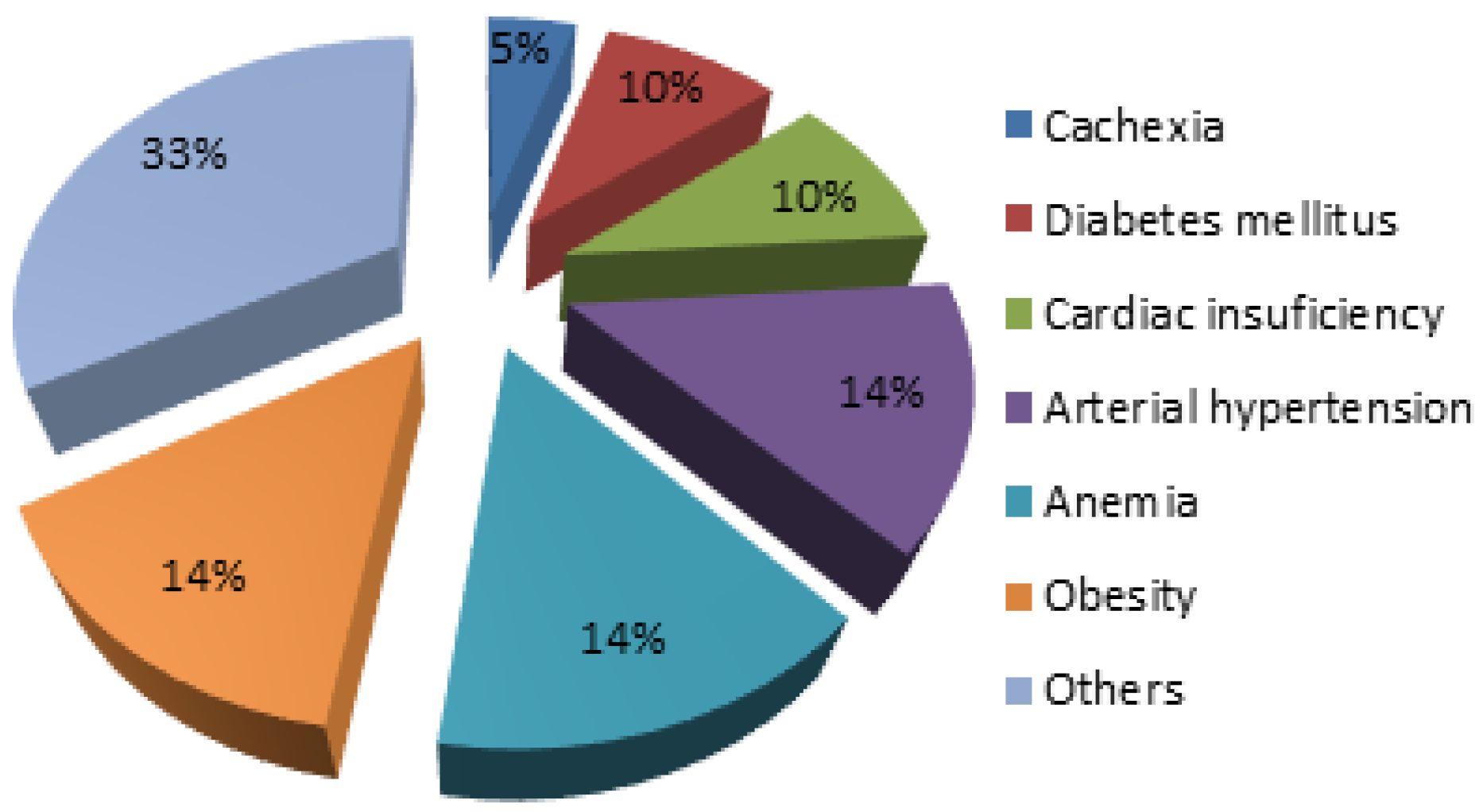The Impact of Patient-Dependent Risk Factors on Morbidity and Mortality Following Gastric Surgery for Malignancies
Abstract
:Introduction
Materials and Methods
Results
| Correlation | Pearson | Statistical significance |
| Anemia < 8g/dl | r = 0.3288 | p = 0.002 |
| Diabetes mellitus | r = 0.5102 | p < 0.0001 |
| Poor nutritional status | r = 0.4018 | p = 0.03 |
| Cardiac failure | r = 0.2315 | p = 0.003 |
Discussions
Conclusions
Conflict of interest disclosure
Compliance with ethical standards
References
- Sung, H.; Ferlay, J.; Siegel, R.L.; Laversanne, M.; Soerjomataram, I.; Jemal, A.; Bray, F. Global Cancer Statistics 2020: GLOBOCAN Estimates of Incidence and Mortality Worldwide for 36 Cancers in 185 Countries. CA Cancer J Clin. 2021, 71, 209–249. [Google Scholar] [CrossRef]
- Liu, J.-Y.; Peng, C.-W.; Yang, X.-J.; Huang, C.; Li, Y. The prognosis role of AJCC/UICC 8th edition staging system in gastric cancer, a retrospective analysis. Am J Transl Res. 2018, 10, 292–303. [Google Scholar] [PubMed]
- Maehara, Y.; Orita, H.; Okuyama, T.; Moriguchi, S.; Tsujitani, S.; Korenaga, D.; Sugimachi, K. Predictors of lymph node metastasis in early gastric cancer. Br J Surg. 1992, 79, 245–247. [Google Scholar] [CrossRef] [PubMed]
- Bartlett, E.K.; Roses, R.E.; Kelz, R.R.; Drebin, J.A.; Fraker, D.L.; Karakousis, G.C. Morbidity and mortality after total gastrectomy for gastric malignancy using the American College of Surgeons National Surgical Quality Improvement Program database. Surgery. 2014, 156, 298–304. [Google Scholar] [CrossRef]
- Martin, A.N.; Das, D.; Turrentine, F.E.; Bauer, T.W.; Adams, R.B.; Zaydfudim, V.M. Morbidity and Mortality After Gastrectomy: Identification of Modifiable Risk Factors. J Gastrointest Surg. 2016, 20, 1554–1564. [Google Scholar] [CrossRef] [PubMed]
- Wang, S.; Xu, L.; Wang, Q.; Li, J.; Bai, B.; Li, Z.; Wu, X.; Yu, P.; Li, X.; Yin, J. Postoperative complications and prognosis after radical gastrectomy for gastric cancer: a systematic review and meta-analysis of observational studies. World J Surg Oncol. 2019, 17, 52. [Google Scholar] [CrossRef] [PubMed]
- Papenfuss, W.A.; Kukar, M.; Oxenberg, J.; Attwood, K.; Nurkin, S.; Malhotra, U.; Wilkinson, N.W. Morbidity and mortality associated with gastrectomy for gastric cancer. Ann Surg Oncol. 2014, 21, 3008–3014. [Google Scholar] [CrossRef] [PubMed]
- Schwarz, S.; Prokopchuk, O.; Esefeld, K.; Gröschel, S.; Bachmann, J.; Lorenzen, S.; Friess, H.; Halle, M.; Martignoni, M.E. The clinical picture of cachexia: a mosaic of different parameters (experience of 503 patients). BMC Cancer. 2017, 17, 130. [Google Scholar] [CrossRef] [PubMed]
- Degiuli, M.; De Manzoni, G.; Di Leo, A.; D’Ugo, D.; Galasso, E.; Marrelli, D.; Petrioli, R.; Polom, K.; Roviello, F.; Santullo, F.; Morino, M. Gastric cancer: Current status of lymph node dissection. World J Gastroenterol. 2016, 22, 2875–2893. [Google Scholar] [CrossRef] [PubMed]
- Smyth, E.C.; Verheij, M.; Allum, W.; Cunningham, D.; Cervantes, A.; Arnold, D.; ESMO Guidelines Committee. Gastric cancer: ESMO Clinical Practice Guidelines for diagnosis, treatment and follow-up. Ann Oncol. 2016, 27 (Suppl. 5), v38–v49. [Google Scholar] [CrossRef] [PubMed]
- Şavlovschi, C.; Comandaşu, M.; Şerban, D. Specifics of diagnosis and treatment in synchronous colorectal cancers (SCC). Chirurgia (Bucur). 2013, 108, 43–45. [Google Scholar] [PubMed]
- Serban, D.; Socea, B.; Balasescu, S.A.; Badiu, C.D.; Tudor, C.; Dascalu, A.M.; Vancea, G.; Spataru, R.I.; Sabau, A.D.; Sabau, D.; Tanasescu, C. Safety of Laparoscopic Cholecystectomy for Acute Cholecystitis in the Elderly: A Multivariate Analysis of Risk Factors for Intra and Postoperative Complications. Medicina (Kaunas). 2021, 57, 230. [Google Scholar] [CrossRef] [PubMed]
- Ciocirlan, M.; Draghia, L.; Manuc, D.; et al. Nutritional status of patients with digestive cancers. INTERDIAB 2017: Diabetes mellitus in internal medicine; Book Series. International Conference on Interdisciplinary Management of Diabetes Mellitus and its Complications; 2017; pp. 132–138. ISSN 2393-3488. [Google Scholar]
- Ciuhu, A.N.; Pantea-Stoian, A.M.; Nitipir, C.; Popescu, M.; et al. Assessment of cachexia in cancer patients with advanced disease. INTERDIAB 2017: Diabetes mellitus in internal medicine; Book Series. International Conference on Interdisciplinary Management of Diabetes Mellitus and its Complications; 2017; pp. 139–147. ISSN 2393-3488. [Google Scholar]
- Bolocan, A.; Paduraru, D.N.; Nitipir, C.; et al. Mixed adenoneuroendocrine carcinoma of the gastrointestinal tract-features, diagnosis, management and prognostics. Romanian Biotechnological Letters. 2018, 23, 14193–14202. [Google Scholar] [CrossRef]
- Georgescu, S.R.; Tampa, M.; Paunica, S.; Balalau, C.; Constantin, V.; Paunica, G.; Motofei, I. Distribution of post-finasteride syndrome in men with androgenic alopecia. 45th Annual Meeting of the European-Society-for-Dermatological-Research. J Invest Dermatol. 2015, 135 (Suppl. 2), S40–S40. [Google Scholar]
- Hainarosie, R.; Zainea, V.; Rusescu, A.; et al. Management of infectious complications in diabetes mellitus mellitus patients. Rom J Leg Med. 2019, 122, 46–51. [Google Scholar] [CrossRef]
- Șerban, D.; Brănescu, C.M.; Smarandache, G.C.; Tudor, C.; Tănăsescu, C.; Tudosie, M.S.; Stana, D.; Costea, D.O.; Dascălu, A.M.; Spătaru, R.I. Safe surgery in day care centers: focus on preventing medical legal issues. Rom J Leg Med. 2021, 29, 60–64. [Google Scholar]




| Patients without postoperative complications | Patients with postoperative complications | ||||
| Variable | Length of the hospital stay (days) | Costs (RON) | Variable | Length of the hospital stay (days) | Costs (RON) |
| Average | 7 | 8,950 | Average | 21 | 21,935 |
| Standard deviation | 2.4 | 3,450 | Standard deviation | 11.5 | 18,419 |
| Hemoglobin | Albumin | Length of stay | ||
| Hemoglobin | Pearson Correlation | 1 | .301** | -.104 |
| Sig. (2-tailed) | .001 | .269 | ||
| N | 114 | 114 | 114 | |
| Albumin | Pearson Correlation | .301** | 1 | .044 |
| Sig. (2-tailed) | .001 | .643 | ||
| N | 114 | 114 | 114 | |
| Length of hospital stay | Pearson Correlation | -.104 | .044 | 1 |
| Sig. (2-tailed) | .269 | .643 | ||
| N | 114 | 114 | 114 |
Disclaimer/Publisher’s Note: The statements, opinions and data contained in all publications are solely those of the individual author(s) and contributor(s) and not of MDPI and/or the editor(s). MDPI and/or the editor(s) disclaim responsibility for any injury to people or property resulting from any ideas, methods, instructions or products referred to in the content. |
© 2021 by the author. 2021 Bogdan Dumitriu, Sebastian Valcea, Gabriel Andrei, Mircea Beuran
Share and Cite
Dumitriu, B.; Valcea, S.; Andrei, G.; Beuran, M. The Impact of Patient-Dependent Risk Factors on Morbidity and Mortality Following Gastric Surgery for Malignancies. J. Mind Med. Sci. 2021, 8, 267-272. https://doi.org/10.22543/7674.82.P267272
Dumitriu B, Valcea S, Andrei G, Beuran M. The Impact of Patient-Dependent Risk Factors on Morbidity and Mortality Following Gastric Surgery for Malignancies. Journal of Mind and Medical Sciences. 2021; 8(2):267-272. https://doi.org/10.22543/7674.82.P267272
Chicago/Turabian StyleDumitriu, Bogdan, Sebastian Valcea, Gabriel Andrei, and Mircea Beuran. 2021. "The Impact of Patient-Dependent Risk Factors on Morbidity and Mortality Following Gastric Surgery for Malignancies" Journal of Mind and Medical Sciences 8, no. 2: 267-272. https://doi.org/10.22543/7674.82.P267272
APA StyleDumitriu, B., Valcea, S., Andrei, G., & Beuran, M. (2021). The Impact of Patient-Dependent Risk Factors on Morbidity and Mortality Following Gastric Surgery for Malignancies. Journal of Mind and Medical Sciences, 8(2), 267-272. https://doi.org/10.22543/7674.82.P267272



